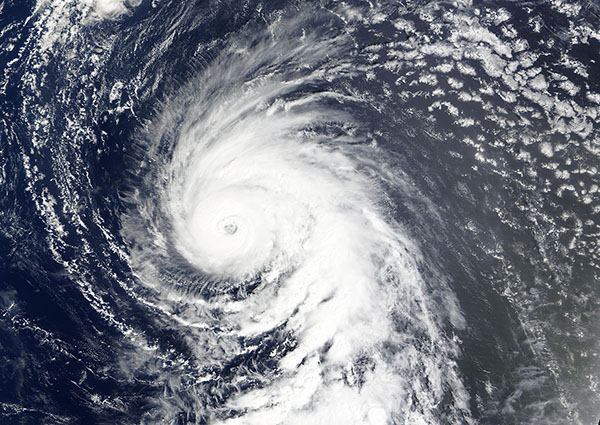Images
October 5, 2024 - Hurricane Kirk
Tweet
Hurricane Kirk was a well-formed major hurricane spinning over the eastern Atlantic Ocean on October 3, 2024. It was the eleventh named storm and the third major hurricane of the 2024 Atlantic hurricane season. A major hurricane is Category 3 or higher on the Saffir-Simpson Hurricane Wind Scale, which means it carries maximum sustained winds of 111 miles per hour (178 km/h) or greater.
The Moderate Resolution Imaging Spectroradiometer (MODIS) on NASA’s Terra satellite acquired this true-color image of Hurricane Kirk on that same day. Near the time the image was acquired, Kirk reached its peak maximum sustained winds of 145 miles per hour (233.4 km/h), which placed it as a Category 4 hurricane. Fortunately, it was located far away from land—about 1,040 miles (1,670 km) east-northeast of the northern Leeward Islands and about 1,670 miles (2685 km) southwest of the Azores.
By the evening of October 4, the National Hurricane Center (NHC) advised that Hurricane Kirk was moving to the northwest over the Atlantic and was beginning to weaken. Maximum sustained winds had dropped to near 130 miles per hour (215 km/h) with higher gusts, which means it remains at Category 4 strength.
The NHC expects Kirk to face increasing wind shear and cooler sea surface temperatures, which should encourage steady weakening over the next several days. Models show the storm curving towards the northeast as it becomes extratropical and approaches France and the United Kingdom later in the week. Meanwhile, despite keeping far away from shore, Hurricane Kirk’s strong winds are expected to churn large waves that will impact the East Coast of the United States over the next several days.
Image Facts
Satellite:
Terra
Date Acquired: 10/3/2024
Resolutions:
1km (821 KB), 500m (1.9 MB),
Bands Used: 1,4,3
Image Credit:
MODIS Land Rapid Response Team, NASA GSFC
Tweet
Hurricane Kirk was a well-formed major hurricane spinning over the eastern Atlantic Ocean on October 3, 2024. It was the eleventh named storm and the third major hurricane of the 2024 Atlantic hurricane season. A major hurricane is Category 3 or higher on the Saffir-Simpson Hurricane Wind Scale, which means it carries maximum sustained winds of 111 miles per hour (178 km/h) or greater.
The Moderate Resolution Imaging Spectroradiometer (MODIS) on NASA’s Terra satellite acquired this true-color image of Hurricane Kirk on that same day. Near the time the image was acquired, Kirk reached its peak maximum sustained winds of 145 miles per hour (233.4 km/h), which placed it as a Category 4 hurricane. Fortunately, it was located far away from land—about 1,040 miles (1,670 km) east-northeast of the northern Leeward Islands and about 1,670 miles (2685 km) southwest of the Azores.
By the evening of October 4, the National Hurricane Center (NHC) advised that Hurricane Kirk was moving to the northwest over the Atlantic and was beginning to weaken. Maximum sustained winds had dropped to near 130 miles per hour (215 km/h) with higher gusts, which means it remains at Category 4 strength.
The NHC expects Kirk to face increasing wind shear and cooler sea surface temperatures, which should encourage steady weakening over the next several days. Models show the storm curving towards the northeast as it becomes extratropical and approaches France and the United Kingdom later in the week. Meanwhile, despite keeping far away from shore, Hurricane Kirk’s strong winds are expected to churn large waves that will impact the East Coast of the United States over the next several days.
Image Facts
Satellite:
Terra
Date Acquired: 10/3/2024
Resolutions:
1km (821 KB), 500m (1.9 MB),
Bands Used: 1,4,3
Image Credit:
MODIS Land Rapid Response Team, NASA GSFC




